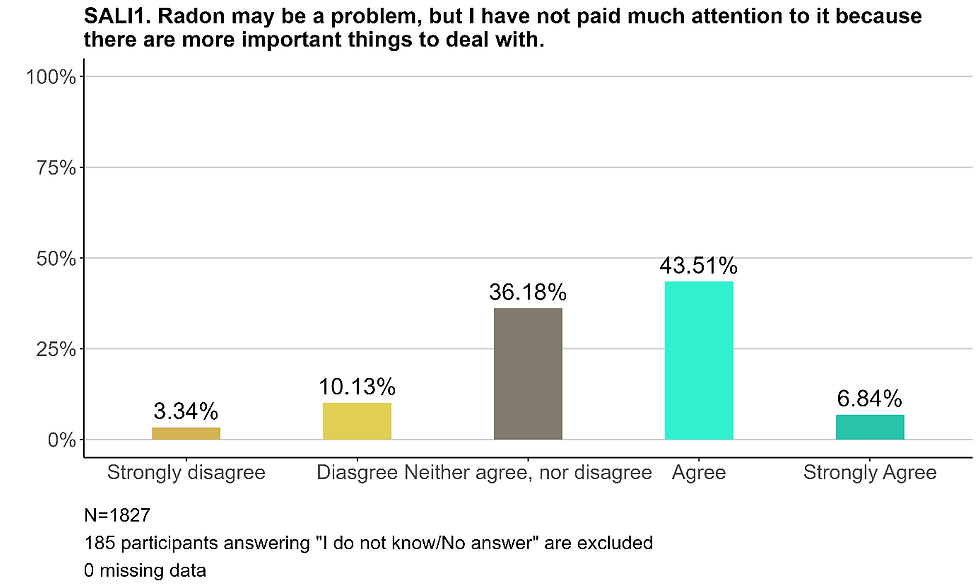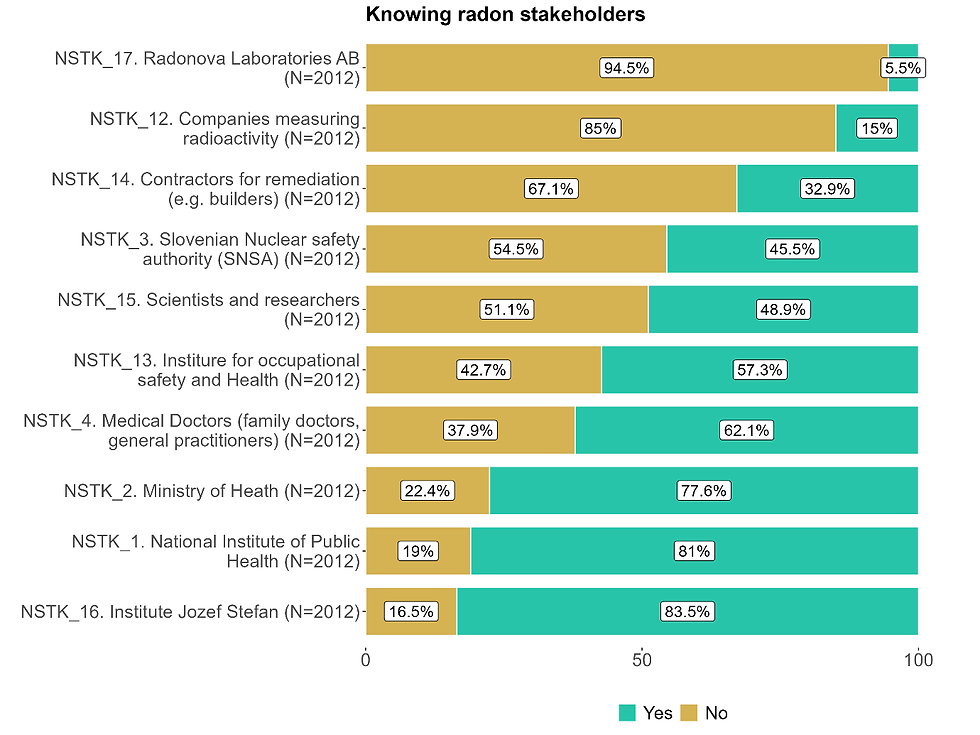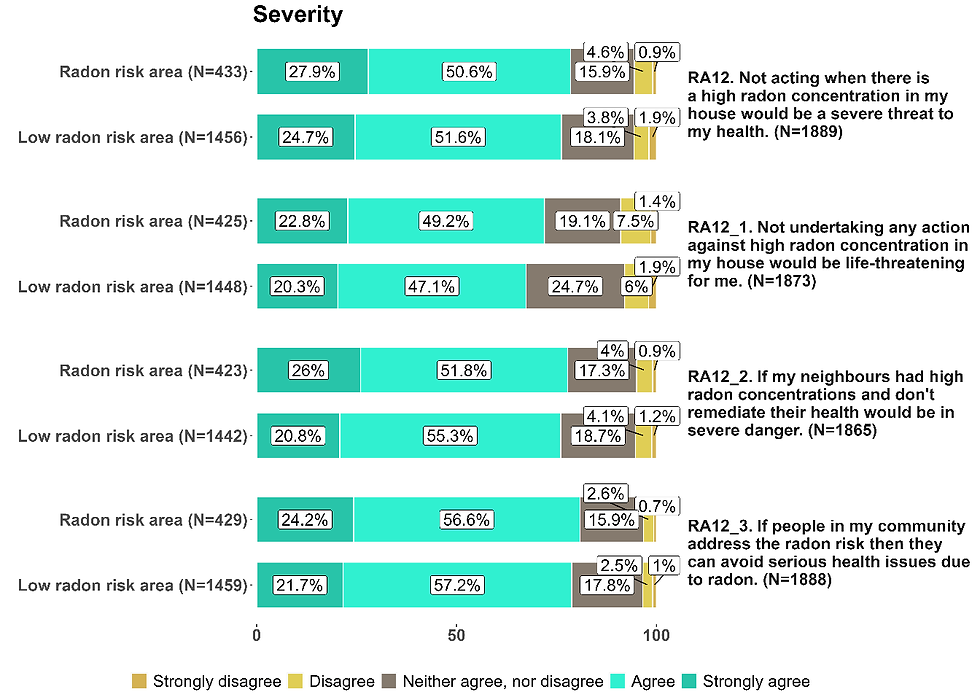
Findings for
Slovenia
Cite as:
Reference: Perko, T., et al., Measuring societal attitudes and behaviours towards radon indoors: A case study of Slovenia. Journal of Environmental Radioactivity, 2024. 272: p. 107355. https://doi.org/10.1016/j.jenvrad.2023.107355
Methodology
The study employed Computer-Assisted Web Interviewing (CAWI) to survey a sample of the Slovenian population. The panel consisted of 25,000 potential respondents from the panel of the marketing company MEDIANA, from which participants for this study were randomly selected. The final sample included 2,012 respondents, representative of the Slovenian population aged 18 and over, with respect to gender, age, and region, and stratified according to the total number of inhabitants in Slovenia. The response rate was 27.6%.
Among the respondents, 77.5% lived in low radon risk areas, 14.2% in medium risk areas, and 8.4% in high risk areas. The average duration of the interviews was 19 minutes, conducted between November 29 and December 8, 2022.
The questionnaire included a short video offering basic and neutral information about radon and the mitigation of elevated radon levels in homes. This video was shown selectively, with the aim of delivering relevant information to those who needed it most, enabling them to respond heuristically to questions regarding attitudes, emotions, and opinions.
To ensure high data quality, a pilot study with 300 participants was conducted in the Walloon region of Belgium prior to the main fieldwork. This was followed by a soft launch in Slovenian, involving a sample of 264 participants.
Ethical approval for the study was granted by the University of Antwerp, Belgium, with additional oversight provided by the RadoNorm ethical committee. The questionnaire development, translation into Slovenian, and fieldwork were funded by the Slovenian Radiation Protection Administration (Služba za varstvo pred sevanji – SRPA), Slovenia. Data were analysed by SCK CEN, Belgium and University Antwerp, Belgium and are available at DOI:10.20348/STOREDB/1179/1308
Download the questionnaire PDF here.
Download a full report PDF here.
Results
Radon protection behaviour
Do people in Slovenia test and mitigate?




Intention to protect from radon
What is the public willingness to adopt radon protection measures in Slovenia?

Radon awareness
Are people in Slovenia aware of radon?


Salience
Is radon indoor seen as an important topic in Slovenia?


Radon Knowledge
How much people in Slovenia know about radon?


Risk perception
How do people in Slovenia perceive radiological, radon and other risks?

Confidence in authorities for risk management
To what extent do Slovenes have confidence in their authorities' ability to manage risks?

Knowing radon stakeholders
Which stakeholders related to radon are known to Slovenes?


Who in Slovenia is recognized as a trustworthy source of information about radon risks?
Truthfulness of radon stakeholders



Which stakeholders involved in radon mitigation in Ireland are recognized as technically competent?
Competence of radon stakeholders



Severity
What are people's beliefs regarding the seriousness of negative consequences due to radon?



Susceptibility
Do people in Slovenia believe that radon increases the likelihood of health consequences?



Response efficacy: remediation
Do individuals believe dwelling remediation is effective in reducing radon concentration?



Self-efficacy
Do residents in Slovenia have confidence in their own ability to conduct radon testing and mitigation effectively?



Perceived behavioural control: financial and other burden and ease
Is radon testing and mitigation perceived as a financial or other burden?


Aesthetic impact of remediation works on a dwelling
Do residents believe that radon mitigation perceived as a financial or other burden?

Economic impact of radon on a property value
Does a radon problem in a building negatively impact its financial value?

Is radon testing and mitigation a common practice within social groups?
Descriptive norms


Subjective norms
Do family members and friends of resopondents care about radon-related issues?


Health effect perception
Do individuals have acquaintances who may have experienced health issues as a result of radon exposure?

Stigma
Is there a risk of stigma associated with radon in dwellings?

Information processing
How do people process information about radon?

Information comprehensiveness
Is there enough information readily accessible?

Information uncertainty
Is there too much uncertainty to make informed decisions?

Affective response to information
Does information related to radon elicit negative emotions?

Preference for post-survey radon related information
Which communication channels are recommended for radon-related communication?

Trustworthiness of radon stakeholders
Who in Slovenia is recognized as a trustworthy source of information about radon risks?

Factors Influencing Behavioural Intention
Radon awareness

Salience

Radon knowledge

Risk perception

Severity

Susceptibility

Response efficacy: remediation

Perceived behavioural control: financial and other burden and ease



Aesthetic impact of remediation works on a dwelling

Economic impact of radon on a property value

Health effect perception

Descriptive norms

Stigma

Information processing


Affective response to information

Relationship Between Radon Awareness and Behavioural Intention to Act on Radon Risk


